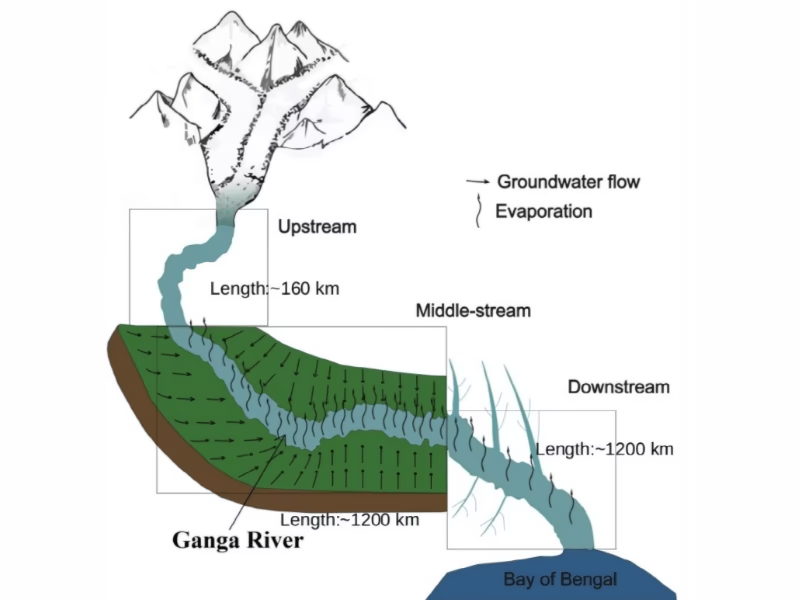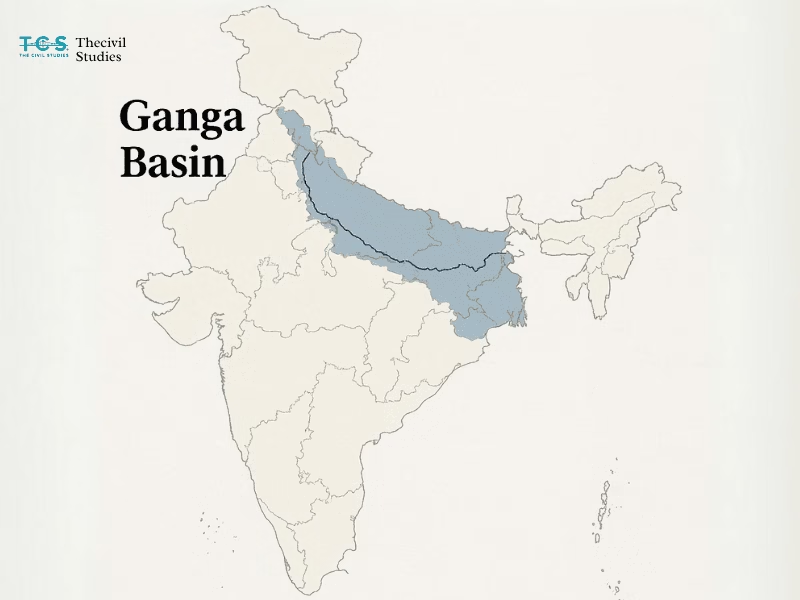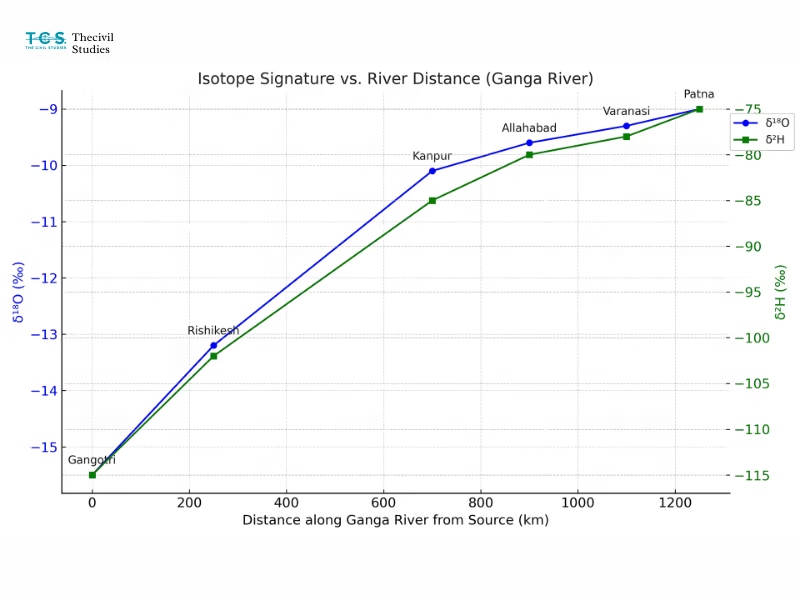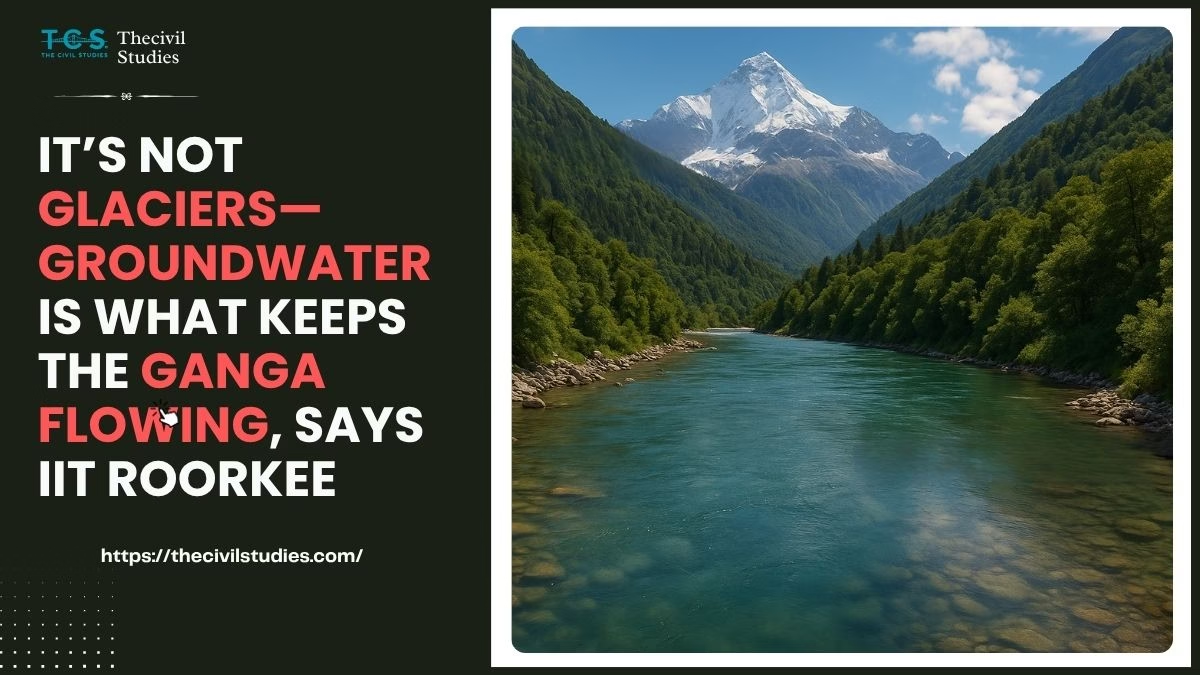Contrary to the long-held perception that Himalayan glacier melt is the primary driver behind the Ganga River’s year-round flow, new research from IIT Roorkee presents a compelling alternative. Using isotopic hydrology techniques, scientists have confirmed that during the lean summer months, baseflow from regional aquifers—not ice melt—is what keeps the Ganga alive, especially through the central Gangetic plains. This challenges decades of hydrological assumptions and highlights growing concerns over groundwater depletion in one of India’s most densely populated and agriculturally critical regions.
Key Technical Insights from the IIT Roorkee Study:
- Study Type: Peer-reviewed field research using stable isotope hydrology
- Technique Used: δ¹⁸O and δ²H isotopic signatures were analyzed to trace water origin
- Key Finding: Over 70% of summer river flow across the central Gangetic plains comes from groundwater discharge (baseflow), not glacier melt
- Geographic Focus: The middle and lower reaches of the Ganga basin, especially in Uttar Pradesh and Bihar
- Implication: Points to a growing dependence on stressed aquifers, with major implications for water security, river basin planning, and climate resilience strategies
- Policy Impact: Suggests a need to shift focus from glacial-fed models to aquifer recharge and groundwater management practices

Revisiting the Source of a Subcontinental Lifeline
For decades, we’ve believed that the Ganga River—one of the most vital freshwater arteries in South Asia—owes its year-round flow to Himalayan glacial melt. But that view, while partly true in the upper reaches, doesn’t hold across the expansive Gangetic plains. What actually sustains the Ganga during the scorching summer months is something far less visible: groundwater.
Recent findings, especially from IIT Roorkee’s detailed isotopic analysis, point clearly to baseflow from shallow and deep aquifers as the dominant source of summer discharge. This isn’t just a shift in academic thinking—it’s a wake-up call. If groundwater is the true backbone of the Ganga’s lean-season flow, then how we manage, protect, and recharge these aquifers directly determines the river’s future.

The Methodological Core: Stable Isotope Hydrology
The IIT Roorkee study, published in Hydrological Processes, moved beyond conventional flow measurement to “fingerprint” the source of the water using stable isotope analysis. This technique is a cornerstone of modern hydrology and provides a definitive method for water source apportionment.
- Isotopic Tracers (δ¹⁸O and δ²H): The analysis centers on the stable isotopes of water, Oxygen-18 (¹⁸O) and Deuterium (²H). Water from different sources exhibits distinct isotopic signatures (expressed in delta notation, δ¹⁸O and δ²H) due to mass-dependent fractionation processes during phase changes (evaporation, condensation).
- Glacial Melt: Water originating from high-altitude glaciers is significantly depleted in heavy isotopes, showing highly negative δ¹⁸O and δ²H values.
- Rainfall: The isotopic composition of rainfall varies but is generally less depleted than glacial melt.
- Groundwater: The isotopic signature of groundwater in a region typically reflects the long-term average of recharging precipitation, giving it a stable and distinct compositional range.

By systematically sampling – the Ganga along its longitudinal profile and analyzing the isotopic composition, the researchers could deconstruct the river’s flow and quantify the proportional contribution from each source. Their findings revealed that the distinct isotopic signature of glacial meltwater rapidly diminishes downstream, and the signature of groundwater becomes the dominant signal in the plains, confirming it as the primary source of summer flow up to Patna
Hydrogeological Context: The Gangetic Aquifer System Under Stress
The significance of the Ganga’s dependence on groundwater is magnified when viewed against the backdrop of the region’s hydrogeological crisis. The Gangetic plains host one of the world’s most exploited aquifer systems.
- Quantitative Depletion: Data from the Gravity Recovery and Climate Experiment (GRACE) satellite mission, a key tool in modern hydrogeology, has been used to quantify the alarming rate of groundwater loss. A study in Environmental Research Letters calculated a net groundwater loss of 226.57 cubic kilometers between 2002 and 2016 (as per the reports). This massive abstraction is primarily driven by agricultural irrigation, which is estimated to be responsible for approximately 80% of the non-renewable groundwater usage (report).
- Reversal of Hydraulic Gradient: In a healthy river system, the groundwater table (potentiometric surface) is higher than the river stage, creating a hydraulic gradient that forces groundwater into the river. Such a river is termed a “gaining” or “influent” stream. However, intensive pumping has lowered the water table to such an extent that in many sections of the Ganga, the gradient has reversed. The river stage is now higher than the surrounding water table, causing river water to leak into the depleted aquifer. The Ganga has transitioned from a “gaining” to a “losing” or “effluent” stream in these areas. This phenomenon is corroborated by observed drops in the Ganga’s summer water levels at rates between 0.5 and 38.1 cm per year in its lower reaches. This directly reduces the river’s baseflow and overall discharge.
4. Engineering and Policy Implications: A Mandate for Integrated Water Resource Management
This new hydrological paradigm has profound implications for water resource engineering and national policy.
- Recalibration of Hydrological Models: Existing water balance models for the Ganga basin that overemphasize glacial contribution and underestimate river-aquifer interaction are now obsolete. Future models must be recalibrated with a stronger focus on groundwater dynamics, baseflow contributions, and the impacts of abstraction.
- Shifting from Pollution Abatement to Volumetric Management: Initiatives like the National Mission for Clean Ganga (NMCG), while vital, have concentrated on improving water quality by targeting point-source pollution. The scientific evidence mandates that this focus must expand to include water quantity. The rejuvenation of the Ganga is not just about making it cleaner, but about ensuring there is enough water to clean.
- The Imperative of Managed Aquifer Recharge (MAR): A passive reliance on monsoon recharge is no longer sufficient. An active, engineering-led approach is required. This includes implementing MAR techniques on a large scale, such as:
- Spreading basins and check dams to increase infiltration.
- Recharge shafts and injection wells to directly replenish deeper aquifers.
- Revitalization of wetlands and traditional water bodies, which act as natural recharge zones.
- Climate Change as a Stress Multiplier: Climate models for the basin project increased temperature variability and more erratic, high-intensity rainfall events, which favor rapid runoff over gradual infiltration, further hindering natural aquifer recharge (River Ganga Research). This reinforces the need for engineered recharge solutions.
5. Conclusion: A Call for Science-Driven Stewardship
The IIT Roorkee study serves as a critical inflection point in our understanding of the Ganga. It scientifically decouples the river’s summer health from distant glaciers and inextricably links it to the invisible, underlying aquifer system. For engineers, hydrologists, and policymakers, the message is clear: the path to a sustainable Ganga lies underground.
The challenge now is to translate this scientific understanding into actionable policy. This requires a paradigm shift from a fragmented to an integrated management approach, where surface water and groundwater are treated as a single, indivisible resource. The future of the Ganga depends on a new era of stewardship—one that is driven by robust science, grounded in hydrogeological reality, and executed through sound water resource engineering. The continued neglect of the Gangetic aquifer system is not just an environmental oversight; it is an existential threat to the Ganga itself.
FAQ Frequently Asked Questions
1. What is the main source of the Ganga River’s summer flow?
The main source of the Ganga River’s summer flow, especially in the central Gangetic plains, is groundwater—specifically baseflow from aquifers—rather than Himalayan glacial melt, according to a peer-reviewed study by IIT Roorkee.
2. Is the Ganga River glacier-fed or groundwater-fed?
While the upper reaches of the Ganga originate from glacial sources like the Gangotri glacier, most of its downstream flow, particularly in summer, is sustained by groundwater discharge across the plains.
3. What is baseflow, and why is it important for the Ganga?
Baseflow is the portion of river water that comes from groundwater seepage into the riverbed. It’s a vital component that keeps the Ganga flowing during dry months when rainfall and snowmelt are minimal.
4. What did the IIT Roorkee study on the Ganga River find?
The IIT Roorkee study used stable isotopes (δ¹⁸O and δ²H) to trace the water’s origin and found that groundwater is the dominant contributor to the Ganga’s flow up to Patna, especially in summer.
5. How does groundwater affect the Ganga River’s future?
Over-extraction of groundwater can reduce baseflow, threatening the long-term sustainability of the Ganga. If aquifers continue to deplete, parts of the river could eventually dry up during non-monsoon seasons.
6. Why is this discovery important for water policy in India?
This finding shifts focus from protecting glaciers to urgently managing and conserving groundwater resources. It calls for integrated river-aquifer management in national water policy and urban planning.
7. Are glaciers still important for the Ganga River?
Yes, glaciers play a crucial role in the headwaters of the Ganga, but their contribution significantly declines downstream. In the plains, groundwater dominates the river’s flow pattern.
8. What are δ¹⁸O and δ²H isotopes in hydrology?
δ¹⁸O (Oxygen-18) and δ²H (Deuterium) are stable isotopes used to trace the source of water. Different sources—glacier, rain, groundwater—have unique isotopic signatures, helping scientists determine the origin of river water.
9. How can we protect the Ganga’s baseflow?
Protecting the Ganga’s baseflow requires sustainable groundwater use, restoring aquifer recharge zones, preventing urban over-extraction, and integrating hydrology into river basin development plans.
10. Does climate change impact the Ganga River’s flow?
Yes. Rising temperatures affect both glacier melt patterns and groundwater recharge rates. With groundwater now confirmed as the main contributor to summer flow, climate change poses a dual threat to the river’s long-term health.





